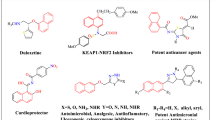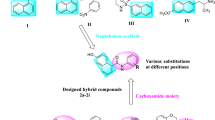Abstract
α-Glucosidase plays a major role in degradation of carbohydrates to glucose. Therefore, inhibition of this enzyme can be useful in the treatment of carbohydrate-related diseases such as diabetes, cancer, and viral infections. In this study, a new series of acridine-9-carboxamide linked to 1,2,3-triazole-N-phenylacetamide derivatives 5a–m were designed, synthesized, and evaluated as potent α-glucosidase inhibitors. All the synthesized compounds showed excellent to good inhibitory activity against α-glucosidase with IC50 values of 80.3 ± 0.9–564.3 ± 7.2 µM in comparison with standard drug acarbose (IC50 value = 750.0 ± 10.5 μM). Among the synthesized compounds, the most active compound was 3-bromo derivative 5h with inhibitory activity around 9.3 times more than acarbose. this compound was selected for farther biological evaluations. Kinetic study of compound 5h revealed that it is a competitive inhibitor against α-glucosidase. Docking study of compound 5h and its regioisomer 5i with 4-bromo substituent were also carried out in the active site of α-glucosidase to gain an insight into the interaction modes of the synthesized compounds and rationalized structure–activity relationship between these two compounds. Compound 5h was also evaluated against α-amylase and no activity was observed in comparison with acarbose. Furthermore, in vitro cytotoxic assay of compound 5h against human normal and cancer cell lines HDF and MCF-7, respectively, revealed that this compound is a noncytotoxic agent. In silico pharmacokinetic and toxicity assays of compound 5h was performed and obtained results were compared with acarbose.





Similar content being viewed by others
References
Abolhasani MH, Safavi M, Goodarzi MT, Kassaee SM, Azin M (2018) Identification and anti-cancer activity in 2D and 3D cell culture evaluation of an Iranian isolated marine microalgae Picochlorum sp. RCC486. DARU J Pharm Sci 26:105–116
Adib M, Peytam F, Rahmanian-Jazi M, Mahernia S, Bijanzadeh HR, Jahani M, Mohammadi-Khanaposhtani M, Imanparast S, Faramarzi MA, Mahdavi M, Larijani B (2018) New 6-amino-pyrido [2, 3-d] pyrimidine-2, 4-diones as novel agents to treat type 2 diabetes: a simple and efficient synthesis, α-glucosidase inhibition, molecular modeling and kinetic study. Eur J Med Chem 155:353–363
Ahmad I (2016) Recent insight into the biological activities of synthetic xanthone derivatives. Eur J Med Chem 116:267–280
Aispuro-Pérez A, López-Ávalos J, García-Páez F, Montes-Avila J, Picos-Corrales LA, Ochoa-Terán A, Bastidas P, Montaño S, Calderón-Zamora L, Osuna-Martínez U, Sarmiento-Sánchez JI (2020) Synthesis and molecular docking studies of imines as α-glucosidase and α-amylase inhibitors. Bioorg Chem 94:103491
Asemanipoor N, Mohammadi-Khanaposhtani M, Moradi S, Vahidi M, Asadi M, Faramarzi MA, Mahdavi M, Biglar M, Larijani B, Hamedifar H, Hajimiri MH (2020) Synthesis and biological evaluation of new benzimidazole-1, 2, 3-triazole hybrids as potential α-glucosidase inhibitors. Bioorg Chem 95:103482
Asgari MS, Mohammadi-Khanaposhtani M, Kiani M, Ranjbar PR, Zabihi E, Pourbagher R, Rahimi R, Faramarzi MA, Biglar M, Larijani B, Mahdavi M (2019) Biscoumarin-1, 2, 3-triazole hybrids as novel anti-diabetic agents: design, synthesis, in vitro α-glucosidase inhibition, kinetic, and docking studies. Bioorg Chem 92:103206
Bioinformatics and Molecular Design Research Center (2014) PreADMET program. Bioinformatics and Molecular Design Research Center, Seoul, South Korea. http://preadmet.bmdrc.org
Chiba S (1997) Molecular mechanism in α-glucosidase and glucoamylase. Biosci Biotechnol Biochem 61:1233–1239
Derosa G, Maffioli P (2012) α-Glucosidase inhibitors and their use in clinical practice. Arch Med Sci 8:899
Dong Y, Zhang B, Sun W, Xing Y (2019) Intervention of prediabetes by flavonoids from Oroxylum indicum. In Bioactive food as dietary interventions for diabetes. Academic Press, pp 559–575
Gurram V, Garlapati R, Thulluri C, Madala N, Kasani KS, Machiraju PK, Doddapalla R, Addepally U, Gundla R, Patro B, Pottabathini N (2015) Design, synthesis, and biological evaluation of quinazoline derivatives as α-glucosidase inhibitors. Med Chem Res 24:2227–2237
Hiele M, Ghoos Y, Rutgeerts P, Vantrappen G (1992) Effects of acarbose on starch hydrolysis. Dig Dis Sci 37:1057–1064
Hollander P (1992) Safety profile of acarbose, an α-glucosidase inhibitor. Drugs 44:47–53
Howe JD, Smith N, Lee MR, Ardes-Guisot N, Vauzeilles B, Désiré J, Baron A, Blériot Y, Sollogoub M, Alonzi DS, Butters TD (2013) Novel imino sugar α-glucosidase inhibitors as antiviral compounds. Bioorg Med Chem 21:4831–4838
Iqbal S, Khan MA, Javaid K, Sadiq R, Fazal-ur-Rehman S, Choudhary MI, Basha FZ (2017) New carbazole linked 1, 2, 3-triazoles as highly potent non-sugar α-glucosidase inhibitors. Bioorg Chem 74:72–81
Kumar R, Kaur M, Kumari M (2012) Acridine: a versatile heterocyclic nucleus. Acta Pol Pharm 69:3–9
Mohammadi-Khanaposhtani M, Rezaei S, Khalifeh R, Imanparast S, Faramarzi MA, Bahadorikhalili S, Safavi M, Bandarian F, Esfahani EN, Mahdavi M, Larijani B (2018) Design, synthesis, docking study, α-glucosidase inhibition, and cytotoxic activities of acridine linked to thioacetamides as novel agents in treatment of type 2 diabetes. Bioorg Chem 80:288–95.
Pili R, Chang J, Partis RA, Mueller RA, Chrest FJ, Passaniti A (1995) The α-glucosidase I inhibitor castanospermine alters endothelial cell glycosylation, prevents angiogenesis, and inhibits tumor growth. Cancer Res 55:2920–2926
Power RF (2003) Enzymatic conversion of starch to fermentable sugars. The alcohol textbook, pp 23–32
Qamar R, Saeed A, Saeed M, Shah BH, Ashraf Z, Abbas Q, Seo SY (2018) Synthesis and enzyme inhibitory kinetics of some novel 3-(substituted benzoyl)-2-thioxoimidazolidin-4-one derivatives as α-glucosidase/α-amylase inhibitors. Med Chem Res 27:1528–1537
Rahim F, Zaman K, Taha M, Ullah H, Ghufran M, Wadood A, Rehman W, Uddin N, Shah SA, Sajid M, Nawaz F (2020) Synthesis, in vitro alpha-glucosidase inhibitory potential of benzimidazole bearing bis-Schiff bases and their molecular docking study. Bioorg Chem 94:103394
Sharma P, Dayma V, Dwivedi A, Baroliya PK, Tripathi IP, Vanangamudi M, Chauhan RS, Goswami AK (2020) Synthesis of sulpha drug based hydroxytriazene derivatives: anti-diabetic, antioxidant, anti-inflammatory activity and their molecular docking studies. Bioorg Chem 96:103642
Shimada Y, Nishimura E, Hoshina H, Kobayashi H, Higuchi T, Eto Y, Ida H, Ohashi T (2014) Proteasome inhibitor bortezomib enhances the activity of multiple mutant forms of lysosomal α-glucosidase in pompe disease. JIMD Rep 18:33–39
Tsutsumi LS, Gündisch D, Sun D (2016) Carbazole scaffold in medicinal chemistry and natural products: a review from 2010-2015. Curr Top Med Chem 16:1290–1313
Wang G, Wang J, He D, Li X, Li J, Peng Z (2016) Synthesis and biological evaluation of novel 1, 2, 4-triazine derivatives bearing carbazole moiety as potent α-glucosidase inhibitors. Bioorg Med Chem Lett 26:2806–2809
Yang CY, Yen YY, Hung KC, Hsu SW, Lan SJ, Lin HC (2019) Inhibitory effects of pu-erh tea on alpha glucosidase and alpha amylase: a systemic review. Nutr Diabetes 9:1–6
Ye GJ, Lan T, Huang ZX, Cheng XN, Cai CY, Ding SM, Xie ML, Wang B (2019) Design and synthesis of novel xanthone-triazole derivatives as potential antidiabetic agents: α-glucosidase inhibition and glucose uptake promotion. Eur J Med Chem 177:362–373
Author information
Authors and Affiliations
Corresponding authors
Ethics declarations
Conflict of interest
The authors declare that they have no conflict of interest.
Additional information
Publisher’s note Springer Nature remains neutral with regard to jurisdictional claims in published maps and institutional affiliations.
Supplementary information
Rights and permissions
About this article
Cite this article
Sepehri, N., Asemanipoor, N., Mousavianfard, S.A. et al. New acridine-9-carboxamide linked to 1,2,3-triazole-N-phenylacetamide derivatives as potent α-glucosidase inhibitors: design, synthesis, in vitro, and in silico biological evaluations. Med Chem Res 29, 1836–1845 (2020). https://doi.org/10.1007/s00044-020-02603-7
Received:
Accepted:
Published:
Issue Date:
DOI: https://doi.org/10.1007/s00044-020-02603-7




